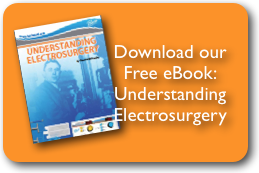 A high-frequency desiccator is an electrosurgical device which allows the physician to perform simple, outpatient procedures to treat a number of common skin lesions. Small superficial skin lesions such as small angiomas, nevi and skin tags are ideal candidates for this approach. Utilizing a treatment electrode that remains cool to the touch, electrical energy is transferred to the tissue causing excitation and effectively destroying the lesion with very little, if any, discomfort to the patient.
A high-frequency desiccator is an electrosurgical device which allows the physician to perform simple, outpatient procedures to treat a number of common skin lesions. Small superficial skin lesions such as small angiomas, nevi and skin tags are ideal candidates for this approach. Utilizing a treatment electrode that remains cool to the touch, electrical energy is transferred to the tissue causing excitation and effectively destroying the lesion with very little, if any, discomfort to the patient.
The purposes for utilizing a high-frequency desiccator are to destroy and remove malignant or benign skin lesions and to coagulate blood vessels.
The most common techniques employed in the process of those functions include:
-
Desiccation - drying out
-
Fulguration - sparking
-
Coagulation - stopping blood flow
Desiccation
In a desiccation procedure, an active electrode is applied to the surface of the lesion. The lesion is then quickly destroyed and removed.
This process can be applied effectively in the treatment of:
-
Skin tags
-
Cherry angiomas
-
Actinic keratosis
-
Verrucae vulgaris
-
Verrucae plana
Fulguration
In fulguration, the electrode does not make actual contact with the skin, but is held close to the surface, generating an electric spark. This procedure is non-invasive, destroying the targeted tissue with minimal epidermal impact.
Some skin lesions that may be effectively treated by fulguration include:
-
Cherry angiomas
-
Condyloma acuminatum
-
Molluscum contagiosum
-
Seborrheic keratosis
-
Verrucae vulgaris
Electrocoagulation
Electrocoagulation is an extremely effective option for the clotting of small vessels in superficial epidermal tissues. When the targeted blood vessel has a diameter of less than 2 - 3 mm, electrocoagulation is ideal for consideration. Customarily, a treatment electrode featuring a 2 - 5 mm metallic sphere at the tip is utilized, which is sufficient for hemostasis of small blood vessels.
Electrocoagulation can be an effective treatment procedure for:
-
Cherry angiomas
-
Spider angiomas
-
Pyogenic granulomas
-
Sebaceous hyperplasia
-
Telangiectasias
Other electrosurgical units (ESUs) send electrical charges through the patient tissues and so require a return channel to get the charge back to the generator. In the monopolar mode, this is accomplished through the use of a return, or dispersive, pad. In the bipolar mode a two-pronged, forceps-like, electrode is used for that purpose. A high-frequency desiccator, like the Aaron 940, provides desiccation and fulguration modalities only. It does not provide a "cut" function, or send electrical charges through the tissues and so requires only one terminal, or electrode.
At Bovie Medical Corporation, we understand the challenges and complexities involved with surgical procedures and patient care. Products like our Aaron 940 high-frequency desiccator are designed to keep your clients safe and at the forefront of medical technology. We are proud to be able to make these durable medical devices available to medical professionals at an economical cost.




